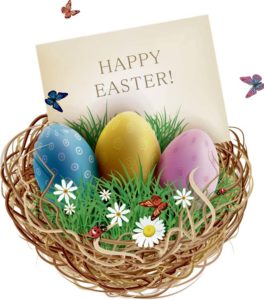by Amanda Hayward
contributing writer
Egg painting, festivals, bonfires, Easter games and feasts all partially sum up a traditional German Easter weekend. Many Easter traditions first began in Germany, and to this day, Easter is one of Germany’s most celebrated holidays. In fact, the first chocolate Easter bunny was made in Germany in the 1800s.
Celebrated alongside chocolate bunnies and the resurrection is the coming of spring. Colorful decorations begin popping up in some German villages like spring flowers and painted eggs hanging from tree branches. Celebrating Easter in Germany gives you the opportunity to incorporate a few of these German traditions and add an interesting twist to your Easter holiday weekend.
Here are a few ways you can celebrate Easter like a German. 
—Decorate—
It is traditional for Germans to decorate a tree in their yard with hand-painted eggs. It is also common to cut branches from trees and bring them inside and decorate them.
To prepare the eggs for hanging, insert two small holes on either side of an egg with a small needle while carefully breaking up the yokes inside. Next, gently blow out the insides through one of the holes until only the shell is left. Decorate your eggs to your liking, and with a glue stick, dab glue next to each other so you can glue both ends of a ribbon to form a loop. Hang your eggs on your tree or branch and you’ve officially decorated like a German.
—Days of Easter—
Green Thursday (Gründonnerstag):
Although some celebrate Green Thursday more than others, it is a tradition for Germans to eat something green on this day, such as spinach, leeks or peas. Green Thursday is a regular working day for most, and in recognition of its other meaning, the Last Supper, some Christians also attend an evening church service to have their feet washed.
Good Friday (Karfreitag):
Everything is quiet and Germans are off work through Easter Monday. Families share a relaxing day out like going for a long walk. They also tend to avoid meat throughout the day, so a fish and/or vegetable dinner is quite traditional. Some Christians attend Mass in remembrance of Jesus dying on the cross. During Mass a candle is lit then kept until Easter morning so it can be lit again at the breakfast table. Good Friday is a day to relax and prepare for Easter morning.
Saturday:
Easter markets are a great way to spend Easter Saturday, while some families prefer a quieter day that includes exchanging decorated eggs or making Easter “nests” (baskets) for the children.
Family, friends and the Easter bunny periodically drop gifts in the nests until Easter Monday.
Some smaller, more religious German towns will attend a Saturday night service and then a bonfire. A tractor and wagon drive through the villages gathering tree branches people have left out in front of their houses. The branches are brought to one pile for a bonfire and residents gather to acknowledge not only the rising of Christ, but the end of winter and coming of spring.
Easter Sunday (Ostern):
While the sun is still down, some celebrate the Easter rising by re-lighting their Good Friday candle, followed by a breakfast with sausage, eggs and Easter bread. The day is spent going to Easter morning church service, going on Easter egg hunts and playing games. Every now and then children will peak to see what goodies have appeared in their nest from family and friends. A traditional Easter dinner is lamb, potatoes and vegetables followed by a traditional lamb or bunny-shaped cake (Osterlamm), which is made with flour, eggs, butter and powdered sugar (see the recipe on page 22).
Easter Monday (Ostermontag):
Easter Monday is a non-working holiday and a time to relax. On this day, family and friends usually take turns visiting each other.
Now, be proud that you celebrated your Easter holiday like a German!


